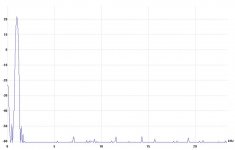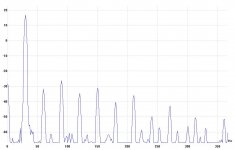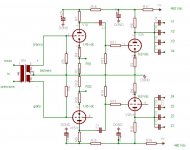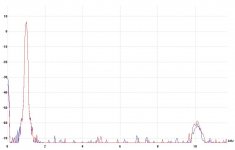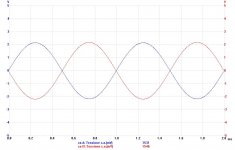These days some people believe transformer phase splitter is the best alternative (Amity by Lynn Olson and others). They uses high quality transformers (Lundahl LL1660…).
But a small and inexpensive transformer may be possible? (EDCOR PC or PCW series)
Has anyone done comparisons and measures?
But a small and inexpensive transformer may be possible? (EDCOR PC or PCW series)
Has anyone done comparisons and measures?
Hi !These days some people believe transformer phase splitter is the best alternative (Amity by Lynn Olson and others). They uses high quality transformers (Lundahl LL1660…).
But a small and inexpensive transformer may be possible? (EDCOR PC or PCW series)
Has anyone done comparisons and measures?
Well,i have never used transformers for Phase splitters,but i think they must have many thousands of turns of wire (very thin),and many thousands of turns have big capacitance...... but i am also curious about it, we will see the specialists answers!
Cheers
I've been using EDCOR XSM10k/10k and XSM10k/600 and find them very good for the price. I've probably run out of time I can tag my utube clips, but this guitar amp uses the XSM10k/10k in the phase splitter.
YouTube - Lucky13 tubeamp
It both measures very well, and sounds fantastic. Even though it has a pretty flat frequency response for a guitaramp, it sounds very crisp. (Usually amps that are flat sound wooly).
I haven't had the time to test them for HiFi, but I plan to, and I expect them to be good to go.
I've even used the same transformers running single-ended with good results, though their frequency respons is not as good run SE. Spot on for guitar though where a little roll-off in both ends is a good thing. (Run PP or 'balanced' like they are intended they have flat freq response).
The 6922 fits very nicely in the mentioned combination.
I used to think of transformers as some iron blob with miles of wire, and imagined in my head the electrons having to pass thru all that thin wire...Well, it's not like that, it is an electromagnetic thingy where the field is excited by the audiosignal and the signal passes thru just as immediately as thru any other passive device. Hmmm, not a good explanation, but don't think of a tranny as miles of wire....ahrg, perhaps someone will explain more textbooky for us?
Anyhow, my Nickle goes for IT-coupling being just as good as RC-coupling. Actually better than RC b/c an IT will deliver power to the load, represents a lower drive impedance, and gives the grids of the power tubes a very low DC resistance path to gnd.
YouTube - Lucky13 tubeamp
It both measures very well, and sounds fantastic. Even though it has a pretty flat frequency response for a guitaramp, it sounds very crisp. (Usually amps that are flat sound wooly).
I haven't had the time to test them for HiFi, but I plan to, and I expect them to be good to go.
I've even used the same transformers running single-ended with good results, though their frequency respons is not as good run SE. Spot on for guitar though where a little roll-off in both ends is a good thing. (Run PP or 'balanced' like they are intended they have flat freq response).
The 6922 fits very nicely in the mentioned combination.
I used to think of transformers as some iron blob with miles of wire, and imagined in my head the electrons having to pass thru all that thin wire...Well, it's not like that, it is an electromagnetic thingy where the field is excited by the audiosignal and the signal passes thru just as immediately as thru any other passive device. Hmmm, not a good explanation, but don't think of a tranny as miles of wire....ahrg, perhaps someone will explain more textbooky for us?
Anyhow, my Nickle goes for IT-coupling being just as good as RC-coupling. Actually better than RC b/c an IT will deliver power to the load, represents a lower drive impedance, and gives the grids of the power tubes a very low DC resistance path to gnd.
These days some people believe transformer phase splitter is the best alternative (Amity by Lynn Olson and others). They uses high quality transformers (Lundahl LL1660…).
But a small and inexpensive transformer may be possible? (EDCOR PC or PCW series)
Has anyone done comparisons and measures?
ISTs are a viable alternative, and can measure and sound good. The keys to excellent performance are to use a good IST. Secondly, drive its primary with a VT that has a low r(p) (low-u triodes such as the vertical deflection finals) and use fixed bias on the driver.
Low r(p) contributes to good low frequency performance since the lower the r(p), the smaller the percentage of Lpri it represents. Fixed bias gets rid of the cathode bias resistor, which if not bypassed, increases the effective r(p) of any triode, and if bypassed, adds capacitive currents to the cathode circuit, and with triodes, capacitive cathode currents are capacitive plate currents. This can cause resonances with primary inductance that can cause some nasty distortion.
Of course, if you're doing a design that includes ISTs, it had better have some excellent open loop performance since ISTs don't play very well with gNFB.
Input transformers are a better option and are considerably cheaper than interstage transformers. A good set of IT will cost more than a pair of output transformers, where as inputs of acceptable quality can be had for less than $60.00 a pair.
Shoog
Shoog
Miles, Would LED bias of the stage driving the IT be a reasonable alternative to fixed in regard to low effective rp and low reactance?
Miles, Would LED bias of the stage driving the IT be a reasonable alternative to fixed in regard to low effective rp and low reactance?
LED bias would most likely work just fine for that.
Why use cathode resistors for a phase splitting duty? Each phase of the IST goes to each plate and the cathodes go together. From the cathodes there is one resistor to gnd and for best performance you want some resistance here.
One of the best for thi purpose is Sowter 3575 with OCC wire.
In attach you can see two diagram.
One the input is 20 Vac in input / 1KHz.
the other is 30 Hz 5 Vac in.
The last is a digram of two channels; the signals are the same.
The "ingresso" file is a schematic of a project of big amp ( 8 x EL34 /channel) developped for Audioreview magazine in Italy.
Ciao
Walter
In attach you can see two diagram.
One the input is 20 Vac in input / 1KHz.
the other is 30 Hz 5 Vac in.
The last is a digram of two channels; the signals are the same.
The "ingresso" file is a schematic of a project of big amp ( 8 x EL34 /channel) developped for Audioreview magazine in Italy.
Ciao
Walter
Attachments
Last edited:
Input transformers are a better option and are considerably cheaper than interstage transformers. A good set of IT will cost more than a pair of output transformers, where as inputs of acceptable quality can be had for less than $60.00 a pair.
Shoog
Can you provide some links to these type of transformer from where these could be purchased ?
thanks
- Status
- Not open for further replies.
- Home
- Amplifiers
- Tubes / Valves
- Transformer phase splitter
